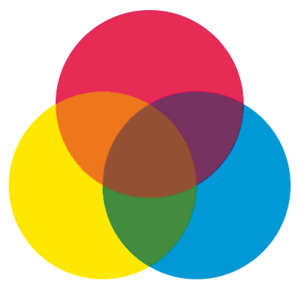What Is The Main Fact About Primary Colors? *

Primary colors (or primary colours) are sets of colors that can exist combined to brand a useful range of colors. The primary colors are those which cannot exist created past mixing other colors in a given color space.
For subtractive combination of colors, as in mixing of pigments or dyes for printing, the CMYK set of primaries is often used. In this system the principal colors are cyan, magenta,and yellow.[1] Other sets include the RYB system of red, yellow, blue, peculiarly used by artists.[2]
For additive combination of colors, equally in overlapping projected lights or in television and reckoner screens, the primary colors commonly used are red, greenish, and blue.
Biological basis
Primary colors are non a fundamental belongings of low-cal but are related to the physiological response of the eye to lite (the way the middle works). For humans, 3 primary colors are usually used, since homo color vision is trichromatic.
Fundamentally, lite is a continuous spectrum of the wavelengths that tin can be detected by the human heart, an infinite-dimensional stimulus space.[3] However, the man eye normally contains but 3 types of color receptors, chosen cone cells. Each color receptor answer to unlike ranges of the colour spectrum. Humans and other species with three such types of colour receptors are known as trichromats.[3]
The condiment primaries are reddish, green, and bluish. Considering of the response curves of the 3 different color receptors in the human centre, these colors are optimal in the sense that the largest range of colors — a gamut — visible by humans tin can be generated by mixing lite of these colors. Additive mixing of red and green calorie-free, produce shades of xanthous or orange. Mixing light-green and blue produces shades of cyan, and mixing red and blue produces shades of purple and magenta. Mixing equal proportions of the additive primaries results in shades of grey; when all iii colors are fully saturated, the result is white. The color space that is generated is called the RGB ("red, greenish, blue") color infinite.
Subtractive primaries

Media that use reflected light and colorants to produce colors are using the subtractive color method of color mixing. In the press industry, to produce the varying colors, utilise the subtractive primaries yellowish, cyan, and magenta together in varying amounts. Subtractive colour works best when the surface or paper, is white, or close to it.
Mixing xanthous and cyan produces shades of dark-green; mixing yellow with magenta produces shades of red, and mixing magenta with cyan produces shades of blue. In theory, mixing equal amounts of all three pigments should produce shades of grayness, resulting in black when all iii are fully saturated, simply in practice they tend to produce dirty brown colors. For this reason, a quaternary "master" paint, black, is often used in improver to the cyan, magenta, and xanthous colors.
The color space generated is the and so-chosen CMYK colour space. The abridgement stands for "Cyan, Magenta, Xanthous, and Blackness" — One thousand stands for "Kohle"[ source? ] (German for coal) and is used to represent blackness[ source? ] as 'B' could be dislocated with 'Blue'.
In do, mixtures of actual materials like paint tend to exist less precise. Brighter, or more than specific colors can be created using natural pigments instead of mixing, and natural properties of pigments can interfere with the mixing. For case, mixing magenta and dark-green in acrylic creates a dark cyan - something which would not happen if the mixing procedure were perfectly subtractive.
Reference
- ↑ Matthew Luckiesh (1915). Color and Its Applications. D. Van Nostrand company. pp. 58, 221. https://books.google.com/?id=0BgCAAAAYAAJ&pg=RA1-PA221&dq=magenta+cyan+yellow+date:0-1923+press.
- ↑ Chris Grimley and Mimi Love (2007). Color, space, and style: all the details interior designers demand to know but tin never find. Rockport Publishers. p. 137. . https://books.google.com/?id=uVxa-_N4LQ4C&pg=PA137&dq=ryb+color+model+paint&q=ryb%20color%20model%20paint.
- ↑ 3.0 3.1 Michael I. Sobel (1989). Lite. University of Chicago Press. pp. 52–62. . https://books.google.com/?id=PDmAdQpmxl8C&pg=PA58&dq=spectrum+color+infinite-dimensional+cones.
Source: https://wiki.kidzsearch.com/wiki/Primary_color
Posted by: hillcalmsen.blogspot.com


0 Response to "What Is The Main Fact About Primary Colors? *"
Post a Comment